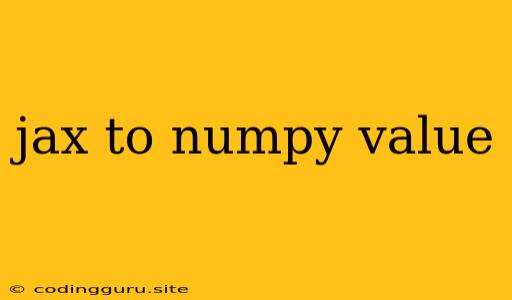Converting JAX Arrays to NumPy Arrays: A Comprehensive Guide
JAX, a high-performance numerical computation library, often works with its own array type, jax.numpy.ndarray. While these arrays offer many advantages for JAX's specific functionalities, there might be scenarios where you need to convert them to NumPy's more widely recognized numpy.ndarray type.
This guide will explore why you might need to convert JAX arrays to NumPy arrays and provide clear steps and examples to achieve this conversion.
Why Convert from JAX Arrays to NumPy Arrays?
Several reasons might motivate you to convert your JAX arrays to NumPy arrays:
- Interoperability with Other Libraries: Many libraries and tools within the Python ecosystem are built around NumPy arrays. Converting to NumPy arrays ensures seamless integration with these tools, allowing you to leverage their functionalities without compatibility issues.
- Data Visualization: Popular data visualization libraries like Matplotlib and Seaborn primarily work with NumPy arrays. Converting your JAX arrays enables you to use these tools to create insightful visualizations of your data.
- Integration with Legacy Code: If your project involves working with existing code that utilizes NumPy arrays, converting your JAX arrays ensures seamless integration with these legacy systems.
Methods for Conversion: A Comprehensive Guide
There are several straightforward methods to convert your JAX arrays to NumPy arrays:
1. numpy.array(): The most basic and direct method is to use the numpy.array() function. This function takes any sequence-like object, including a JAX array, and converts it to a NumPy array.
import jax.numpy as jnp
import numpy as np
# Create a JAX array
jax_array = jnp.array([1, 2, 3, 4])
# Convert to NumPy array
numpy_array = np.array(jax_array)
print(type(numpy_array)) # Output:
2. np.asarray(): Similar to numpy.array(), np.asarray() also converts to NumPy arrays. However, it might be more efficient when dealing with objects that are already NumPy arrays. If you are unsure about the data type, np.asarray() is a safe choice.
import jax.numpy as jnp
import numpy as np
# Create a JAX array
jax_array = jnp.array([1, 2, 3, 4])
# Convert to NumPy array
numpy_array = np.asarray(jax_array)
print(type(numpy_array)) # Output:
3. jax.numpy.to_numpy(): This function is specifically designed for converting JAX arrays to NumPy arrays. It is generally considered the most efficient and recommended approach for this conversion.
import jax.numpy as jnp
import numpy as np
# Create a JAX array
jax_array = jnp.array([1, 2, 3, 4])
# Convert to NumPy array
numpy_array = jnp.to_numpy(jax_array)
print(type(numpy_array)) # Output:
4. numpy.frombuffer(): This method can be used if your JAX array is stored in a buffer-like object, such as a bytearray. This method converts the buffer's contents to a NumPy array.
import jax.numpy as jnp
import numpy as np
# Create a JAX array
jax_array = jnp.array([1, 2, 3, 4])
# Convert to buffer
buffer = jax_array.tobytes()
# Convert to NumPy array
numpy_array = np.frombuffer(buffer, dtype=jax_array.dtype)
print(type(numpy_array)) # Output:
Handling Multi-Dimensional Arrays
The conversion methods discussed above also work seamlessly with multi-dimensional JAX arrays. For example, you can use the jax.numpy.to_numpy() method to convert a 2D JAX array to a NumPy array:
import jax.numpy as jnp
import numpy as np
# Create a 2D JAX array
jax_array = jnp.array([[1, 2], [3, 4]])
# Convert to NumPy array
numpy_array = jnp.to_numpy(jax_array)
print(type(numpy_array)) # Output:
print(numpy_array) # Output: [[1 2] [3 4]]
Considerations: Data Type and Memory Management
When converting between JAX arrays and NumPy arrays, it's essential to consider the data types involved. Although both libraries generally handle data types similarly, it's always a good practice to ensure that the conversion maintains the intended data type integrity.
In terms of memory management, both JAX arrays and NumPy arrays maintain their own memory management schemes. Converting between them might involve data copying, which could potentially impact performance depending on the size of your data.
Conclusion
Converting JAX arrays to NumPy arrays is a straightforward process that opens up possibilities for utilizing the vast array of tools and libraries built around NumPy's data structure. The choice of conversion method depends on the specific scenario and preference, with jax.numpy.to_numpy() generally being the most recommended approach.
Remember to consider data types and potential memory implications when performing this conversion. By understanding these concepts, you can seamlessly integrate JAX arrays into your Python workflow and leverage the full potential of both JAX and NumPy for your numerical computation needs.
